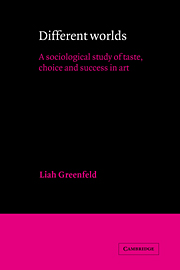Book contents
- Frontmatter
- Contents
- Introduction
- 1 Historical background
- 2 The population of painters and the split into subsystems
- 3 Patterns of success
- 4 The “gatekeepers” – critics
- 5 The “gatekeepers” – curators
- 6 The “gatekeepers” – gallery owners
- 7 The artists – attitudes of Conceptualists and Lyrical Abstractionists
- 8 The artists – attitudes of figurative painters
- 9 The publics
- 10 Conclusion
- Appendices
- Notes
- Index
- Titles in the series
2 - The population of painters and the split into subsystems
Published online by Cambridge University Press: 16 September 2009
- Frontmatter
- Contents
- Introduction
- 1 Historical background
- 2 The population of painters and the split into subsystems
- 3 Patterns of success
- 4 The “gatekeepers” – critics
- 5 The “gatekeepers” – curators
- 6 The “gatekeepers” – gallery owners
- 7 The artists – attitudes of Conceptualists and Lyrical Abstractionists
- 8 The artists – attitudes of figurative painters
- 9 The publics
- 10 Conclusion
- Appendices
- Notes
- Index
- Titles in the series
Summary
In order to describe the existing systems of painting, painters must be classified according to their styles. Since the names they used to identify themselves during different periods varied, it was decided to create a uniform terminology for the description of styles. According to this terminology, the painters were divided into seven style-groups; these include all styles that appeared in the course of the history of Israeli art.
The classification was made according to two principles: (1) the visual similarity among the works of art, their stylistic–technical features; and (2) the place of a certain artistic school on the continuum of the individual freedom of an artist vs. the rigidity of professional requirements towards him.
The seven style-groups are:
Lyrical and Geometric Abstractionism;
Conceptualism;
Surrealism;
Free Figurative Painting;
Naive Painting;
Expressionism;
Realism.
The style-group of Lyrical and Geometric Abstractionism consists mainly of the Abstract Expressionist painters (approximately 90 per cent of the group) and a few Geometric Abstractionists. The works of Abstract Expressionism (the synonyms are Lyrical Abstractionism, tachisme, action painting, art informel) are characterized by the total independence of color and brushwork from the subject, so that the subject becomes unrecognizable. These works are “color, space and movement, presented without any specific reference to observed nature.” The effect of these works of art is achieved by a free spilling or daubing of paint on the canvas and by the use of “the blot, the stain, the spot or the drip.”
- Type
- Chapter
- Information
- Different WorldsA Sociological Study of Taste, Choice and Success in Art, pp. 42 - 51Publisher: Cambridge University PressPrint publication year: 1989

